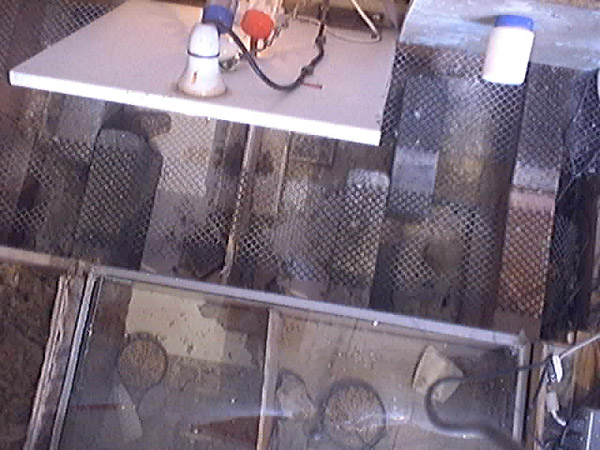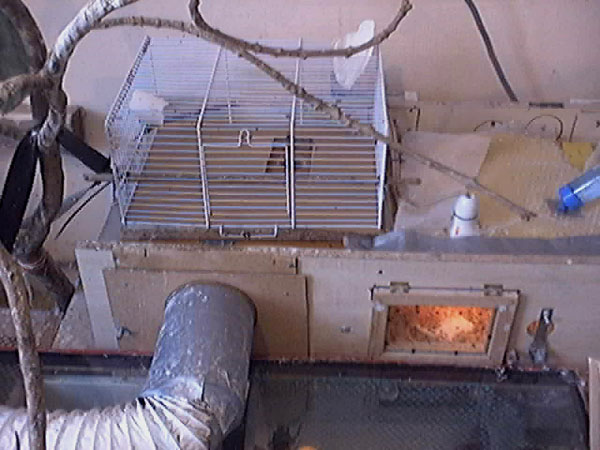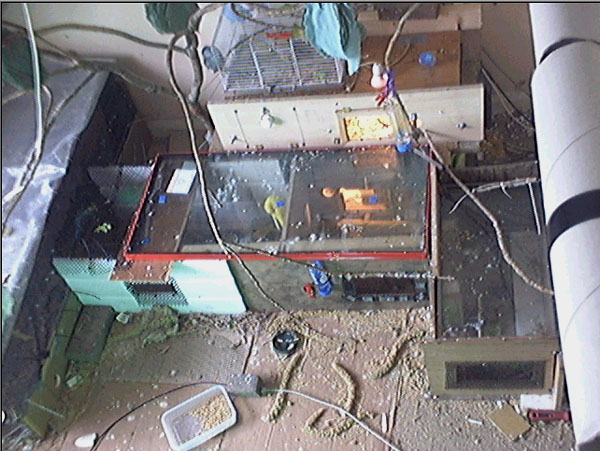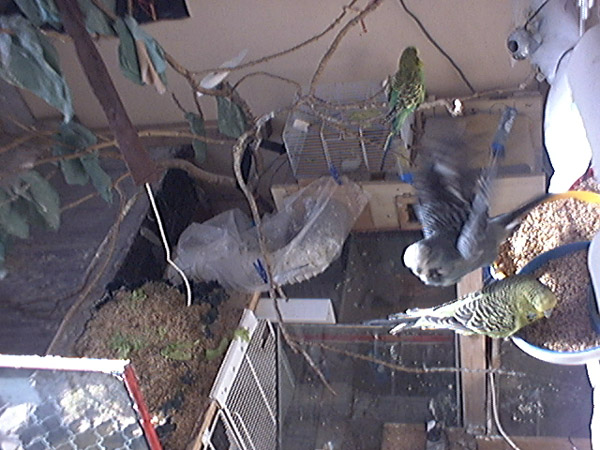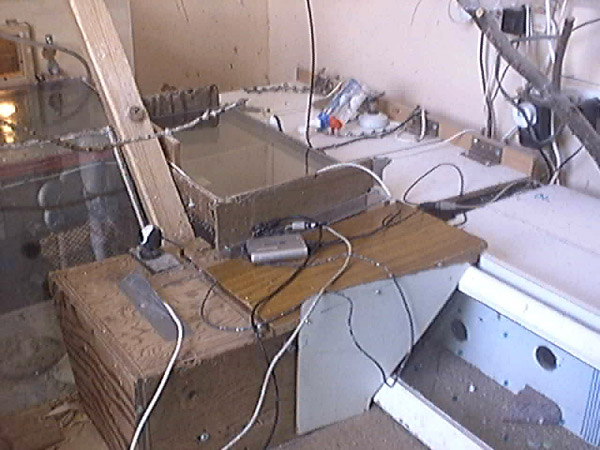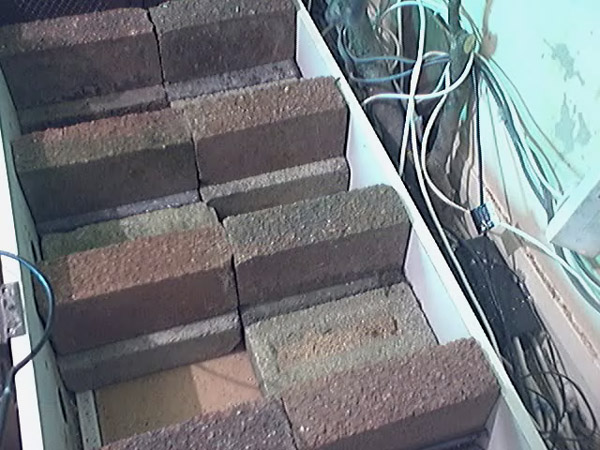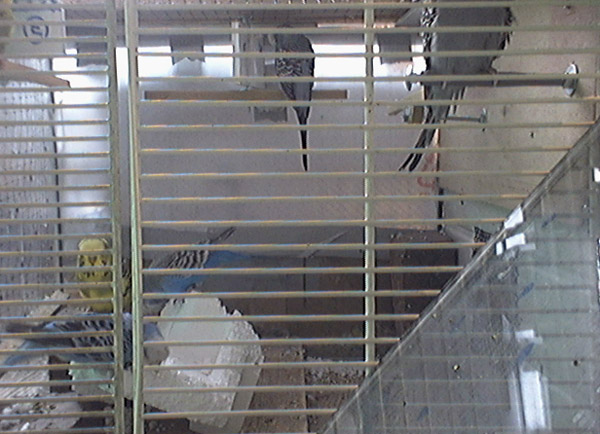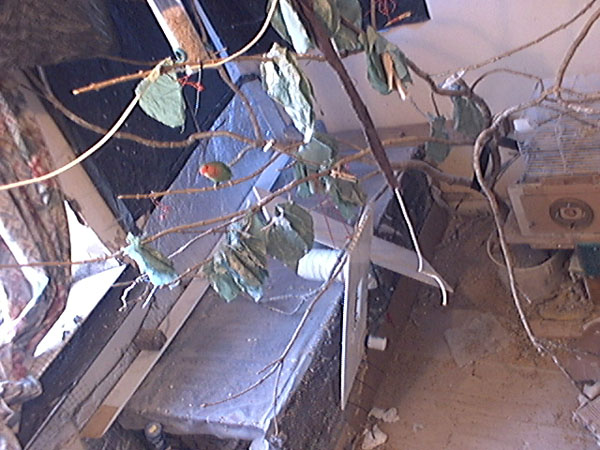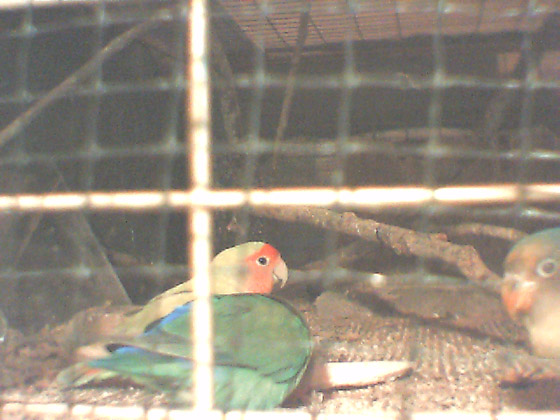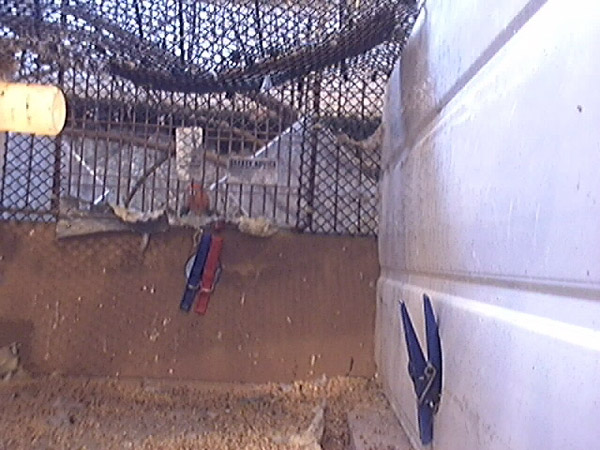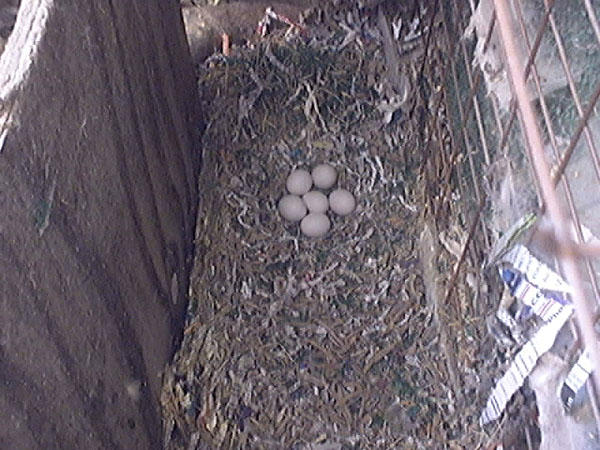|
THE COMPOUNDHOME
THE COMPOUND With a small flock one can manage the problem birds by means of the cages but with larger flocks with persistent problems it's better to build a compound. This consists of multiple interconnecting compartments with or without nesting facilities. Each compartment can be isolated from the rest of the compound by blocking the entrance holes. Dedicate one small compartment to feeding and another larger one to exercising. Other compartments such as forecourts to the nests will be used as a retreat for low ranking birds. The richer and more varied the individual compartments are and the more there are, the better it will work - identical compartments should be avoided. I use glass tops and sides in a lot of the compartments which enables one or two overhead cameras to monitor the birds. Provide a couple of perches in all compartments and lots in the main one used for sleeping. This will generally be the exercise compartment and a grilled front is handy not only for ease of monitoring but also as a perch for the lower ranking birds. Initially these birds will not sleep alone in another compartment but later they will. The baffles on the perches afford a certain amount of safety and security. Nesting facilities in the compound should be considered carefully. I provided eight nests of the brick and wood type, three of which were multiple - room. Three hens used the nests but produced no chicks and some of the nests had to be isolated due to intimidation from other birds. These nests are not as large as a standard breeding cage but the richness makes up for it and the birds accepted them well and were very relaxed when I've done so. Why these hens never produced offspring I don't know but despite this I continued to make the nests available and one of them was even used as a den by a pair of cocks! Once a pair has taken a nest if time is not available for intensive monitoring it's better to isolate it immediately. One hen took up a nest with her mate and laid eggs with very little hassle and it didn't need to be isolated but I think this would be rare. This is a mixed compound and works very well but it's time demanding and you have to know your birds inside out. Segregating the sexes is another approach which I haven't tried but for a beginner I would advise it. I suggest fitting a grill between the two feeding compartments to allow association between the two sexes. The original exercise compartment slept seven birds. Occasionally when there were more than seven birds in the compound they would use the grill but later some would prefer to sleep alone in another section.
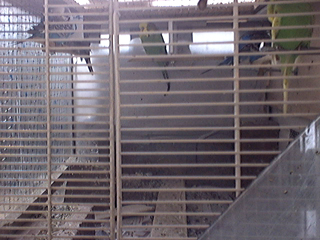
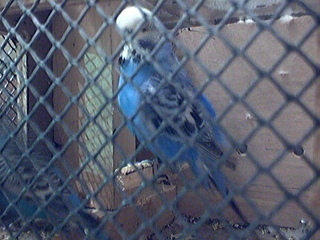
THE SMALL EXERCISE COMPARTMENT / ROOSTER ..... FORECOURT OF THE RIGHT-HAND DOUBLE BRICK-WOOD NEST
THE BRICK-WOOD HOSPITAL The first of the four units to be incorporated into the original compound. A small "flight" was built in front of the hospital for exercise and in conjunction with the DOUBLE BRICK-WOOD NEST and ROOSTER was used to house four problem birds. Shims were cut from the cardboard on the floor to be inserted between the bricks of the DOUBLE BRICK-WOOD NEST which was built to the side of the hospital. BELOW: - HOSPITAL ...................... RIGHT: - RIGHT HAND NEST
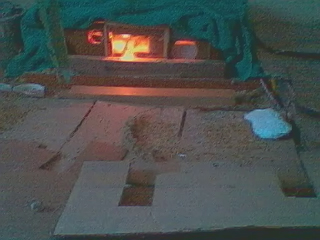
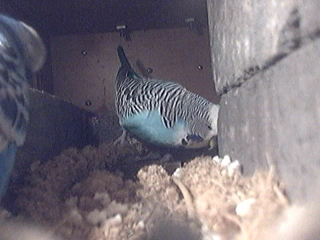
INTERIOR OF THE DOUBLE BRICK - WOOD NESTS AND FORECOURTS
After the double brick-wood nests were completed, the small flight in front of the hospital was divided to form a fore-court and a feeding compartment. Later a double glaze window unit was placed in front of this and formed a "pyramidal walkway" between the rooster and the right hand double brick-wood nest. This enabled the segregated birds to associate with other members of the compound. Association and access for the left hand double brick-wood nest was made possible via the hospital fore-court. Unfortunately this sometimes resulted in problems with the nesting hen who quite rightly considered that area to be part of her territory. There were occasional scuffles when birds were passing through so I decided to create a small passage between the feeding compartment below the Concettina tube to the forecourt of the LEFT HAND DOUBLE - BRICK NEST. This reduced the size of the hospital nest forecourt but as this was the largest it wasn't a significant disadvantage. THE ORIGINAL FLIGHT DIVIDED .......................................... THE HOSPITAL FORECOURT
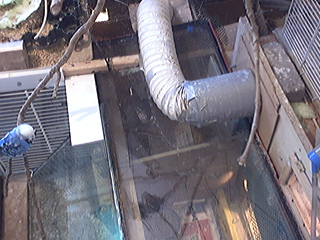
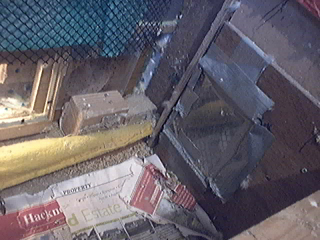
VIEWS FROM THE FEEDING COMPARTMENT HOSPITAL FORECOURT .................................. HOSPITAL PASSAGE
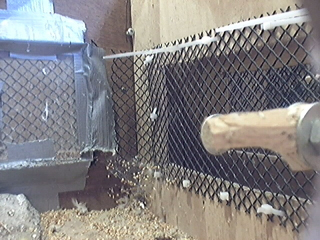
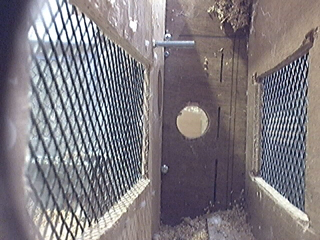
THE NEW HOSPITAL: Later on additional segregated nesting facilities were needed as the existing brick-wood nests were becoming increasingly occupied. As space was becoming short I decided to build a double nest with a single vestibule of the brick-wood type above the existing hospital. Paving stones rather than house bricks were chosen due to weight considerations but the internal floor area was no less than previous designs. The provisions regarding lighting and water would be identical. The forecourt in this case which would allow the cocks some exercises and association had to be built above. This consists of a small hamster cage placed on the roof with a stairway leading to the vestibule below. The unit didn't function as a breeding nest and despite the confined space, it should work as good if not better than a standard breeding cage with the right pairs, The cocks would not only have association with the aviary birds but also with themselves. Unfortunately the "right pairs" never materialised and the unit was tried with single pairs only. A single bonded pair was introduced with the hen laying a blank clutch. Nesting behaviour was normal with the cock spending most of the time in the cage while his mate incubated. She would visit occasionally to stretch her wings and be fed but mainly he would go down to her. He would sleep in the cage. Later another bonded pair was tried but the hen didn't lay. They would both sleep in the one nest with the cock refusing to go into the cage. When it became clear that the hens had little maternal / nesting instincts it was decided to use the unit as a hospital.
A flexible pipe scrapped from a tumble dryer was fitted to enable access from the compound. This leads to the feeding compartment and the cage was often used for association. The tube itself was sometimes used by low ranking cocks for sleeping.
PROBLEMS: Some birds were not able to get into the tube from the FEEDING COMPARTMENT. This involves climbing up to the netting to which the hose is attached and scrambling in. Maybe this difficult combination of gymnastics was beyond the capability of some birds. No hens were able to do this and I suspect a lack of motivation was the cause rather than pure inability - cocks have a greater need to associate than hens. Of the birds that managed it, ALL found their way into the cage quickly but had considerable difficulty in returning. Birds naturally fly UP from the ground and this behaviour is strongly engraved in their psyche. Covering the cage to enhance the light from the vestibule was sometimes necessary but the placing of a "trained" bird in the cage proved more effective.
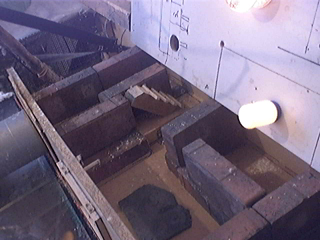
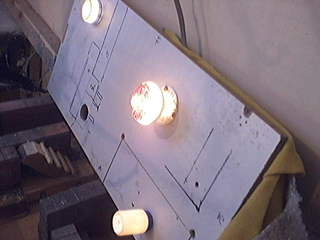
ASSOCIATION WINDOWS Grilled windows are provided on some of the partitions for association and to enable the birds to assess the situation in other compartments. For instance a bird in the rooster will sometimes check the feeding compartment before going in to feed. The grills are made from plastic gutter netting. 5mm cable ties are used for the white plastic partition for the feeding compartment and the HOSPITAL FORECOURT. Other grills are stapled on. A separate segregation pen had already been built at the left hand wall.
WATER PROVISION No food or water is provided in the rooster. Food is only available in the feeding compartment except for lettuce which is put on the hospital cage and also on the netted roof of the feeding compartment. Strict regimes enhances the sense of order and discipline to which many confined birds lack. Water bottles are provided in all three nests plus two in the new hospital and also in the feeding compartment and fore-court to the old hospital which now functions as a nest. HEATING: No heating is provided in any of the compartment / nests. LIGHTING: The vestibules to the DOUBLE BRICK-WOOD nest and the OLD HOSPITAL are illuminated by a 15 Watt sign lamp (pygmy bulb). These are small bulbs and run off the mains. A similar lamp is fitted in the OLD HOSPITAL nursery room. 12 Volt 1.2 Watt M.E.S. bulbs are fitted in the FEEDING compartment, both nursery rooms of the DOUBLE BRICK-WOOD nests and both nursery rooms of the NEW HOSPITAL. All lamps operate with dual intensity (day/night) and are synchronised with the aviary AUTOMATIC LIGHTING SYSTEM.
THE AUTOMATIC LIGHTING SYSTEM: The main room is illuminated by a 100 Watt mains incandescent bulb operated by a MASTER TIMER feeding an AUTO-DIM CONTROLLER. This lamp is switched on automatically in the morning and again in the evening. The switch-on is almost instantaneous whereas the switch-off is controlled by the auto-dimming circuit preceded by an audible warning from a buzzer. This is activated around twenty minutes before the light goes out and intensifies in stages. This interval gives the birds the opportunity to take their last feed and to take up their roosting positions. Also five spot lamps on two separate circuits and a ultra-violet lamp are arranged by means of 24 hour segment timers to start switching off prior to this. The spot lamps provide extra light to some compartments which receive inadequate illumination from the main lamp. The staggered switch-off of the lamps gives late feeders extra prompts to prepare for the night. SPOT 1: A 60 Watt spot lamp fitted to the side of the wardrobe which illuminates the LOVE-BIRDS’ service compartment. SPOT 2: A 60 Watt spot lamp fitted on the wall opposite the SMALL ROOSTER and illuminates this compartment. Spot 3: A 50 Watt "down light" fixed to the same wall and is directed towards the forecourts of the DOUBLE BRICK-WOOD NESTS. SPOT 4: An 80 Watt outdoor spot lamp fitted on the back wall which illuminates the Love-birds' nest. This lamp can also provide extra illumination for the FEEDING COMPARTMENT when the interior lamp blows. SPOT 5: The effectiveness of spot 1 was very low due to the left wall of the Love-birds' service area being largely constructed of wood. Because of this a supplementary 50 Watt "down-light" fixed to the large rooster was directed towards the front pane of this compartment. THE LARGE ROOSTER lamp is connected to one of the circuits and consists of a small bulk-head lamp fitted to the roof of the pen with a 40 Watt incandescent bulb.
Synchronizing the spot lamps to coincide with the birds' feeding times proved difficult as these times varied with the seasons and the habits of the individual birds. A fixed regime was adopted with the lamps being operated three times a day (morning-noon-evening) - the morning and noon phases for about an hour with the evening phase starting from about 17:00h until the staggered switch-off at around 19:15h. The "count-down" sequence is as follows: 1. Circuit (1) switches off. (U.V. lamp, spot 1 and 4.). 2. The compound lamps go low 10 minutes later (Vestibules and nursery compartments). This is accompanied by a low humming sound from the buzzer. 3. The master timer cuts out 10 minutes later (Mains synchronised) accompanied by an increase in volume from the buzzer. 4. Circuit (2) switches off five minutes later (Spots 2,3,5) and the large rooster. 5. Louder Warning buzz five minutes later followed by the room lamp slowly dimming off forty-five seconds later. The lamp in the feeding compartment is on permanently. This elaborate system worked well with some birds taking feed at the stage 1 prompt. However a lot of birds had already taken their last feed well before this. Very occasionally the stage (5) buzz would remind a bird to feed but would often cause them to take up their roosting positions. Before the installation of an extended "count-down" system using spot lamps, some budgies would be seen to feed after the room light went out. However these were colony birds as opposed to cage bred birds. They had a completely different rearing in an attic aviary and were more independent.
NIGHT LIGHTS: Three 15 Watt night lights are provided widely distributed around the room. The main light is fixed to the rear of the wardrobe and is on permanently. Another lamp is fixed to the roof of the DOUBLE BRICK-WOOD NEST with the third being situated behind the NEW HOSPITAL. These two lamps operate at low power and are synchronized with the aviary AUTOMATIC LIGHTING SYSTEM. A separate back-up light is provided in case the power supply or the room lamp fails.
Times are approximate.
LIGHTING PROGRAM (G.M.T.) COMPOUND .............................................. HIGH ................................. LOW .............................................. 07:42 ................................ 19:25
LIGHTING PROGRAM (G.M.T.) AVIARY
MORNING: .............................................. ON ................................... OFF .............................................. 07:55 ................................ 10:30
AFTERNOON: .............................................. ON ................................... OFF .............................................. 15:00 ................................ 19:48
***********************************************************************
THE EXTENSION After a succession of problems with one particular hen I decided to extend the COMPOUND and segregate the sexes. It included three new nests of the BRICK-WOOD type and a larger rooster/exercise pen. This was built on the same wall as the DOUBLE BRICK-WOOD NESTS and was connected to the PYRAMIDAL WALKWAY by a windowed passage. After having her eggs destroyed by her mate I released her into the aviary where she chose a more mature mate and took up a nest on the wardrobe. Things had settled down again and it wasn't necessary to isolate the new extension and the remaining birds had the freedom of the whole compound. One of the new nests was taken by an older bonded pair with the hen laying two unproductive clutches. The new rooster became very popular but despite this the original smaller one was still used by those birds who felt more comfortable there. These decisions are probably made on social grounds rather than any particular physical aspect of the two roosters.
THE INTERSECTION BETWEEN THE ORIGINAL COMPOUND AND THE EXTENSION
There are no refinements to the new nests - just a simple protective enclosure for the hen to raise her young. Sufficient illumination is achieved by the fitting of a glass roof or by using picture frames as used in the "kitchen" of the two compartment BRICK-WOOD NEST. However in this case supplementary lighting will probably be needed in the form of a spot lamp directed towards the nests. The layout of the centre nest is different to the other two and will act as a prompt should a hen enter the wrong nest. The circular mark and stripes on the right hand nest is for the same reason. Both entrances to this section can be blocked to enable the nests to be part of the original compound or the new rooster or both.
INTERIOR OF THE TRIPLE BRICK-WOOD NESTS
THE WINDOWED PASSAGE which connects the old COMPOUND to the new ROOSTER 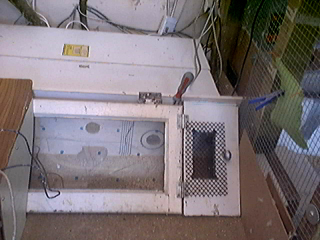
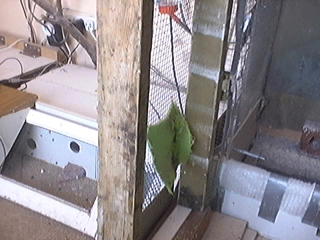
HEN IN THE WINDOWED PASSAGE ....................... INTERIOR OF THE NEW ROOSTER
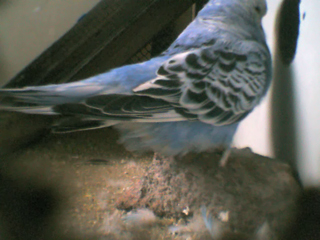
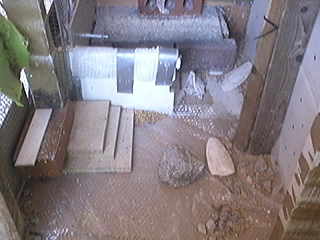
THE NEW ROOSTER WITH DOOR REMOVED This door is a scrapped wooden framed double-glazed window unit, It is simply pushed against the frame beams of the rooster and clamped at the top. The interior surface is covered with 10mm pond netting. This provides a climbing frame for flightless birds and also protection against collision with the glass. Two perch lines are fitted near the ceiling for exercise and roosting. These consists of sections of white 13 Amp power cable which are ideal for the feet and are visible in very low light. A seed hopper and water bottle are also provided. 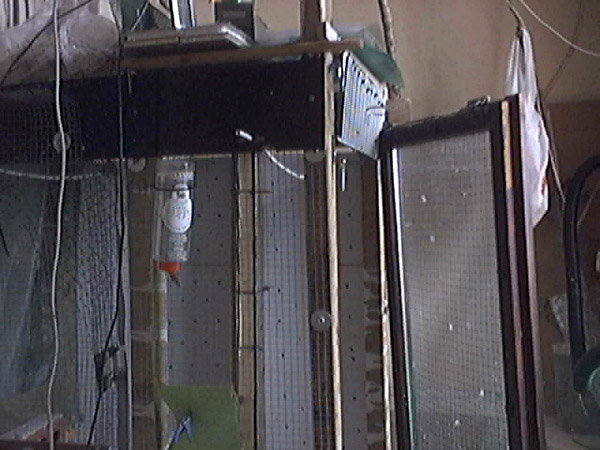
SEGREGATION CONTENTIONS: Most disputes over a particular bird will resolve themselves without any intervention with the lower ranking bird choosing to flee rather than engage in combat. Although rare, these combats do occur and can result in death unless the situation is spotted and dealt with in time. Segregate the bird/birds who are not bonded for the duration of the nesting. This will be a maximum of about two months. INTIMIDATION: Until we know more about the psychology of these creatures it's difficult to identify the cause of the inherent aggression that some birds seem to possess. Most hens will intimidate a brooding hen at her nest at some stage in their development but few will resort to physically attacking her. these individuals will usually be youngsters in their first year of life and past sexual maturity. A lot of mature hens with experience will continue to brood despite a challenging hen at the entrance and only come off the eggs occasionally to chase the bird away. In this situation no intervention is necessary. If she is forced off her eggs a lot or the hen is seen to actually lean half way into the nest then it should be put in the COMPOUND. If due to misjudgement or insufficient monitoring an attack has already taken place then first cage the bird for two weeks to send a clear message to the colony then place in the COMPOUND for eight months. Less serious transgressions such as intimidation should result in segregation for the duration of the hens nesting. The philosophy behind the COMPOUND is segregation and not punishment. The birds should be given every opportunity to lead a worthwhile and contented existence in a rich and stimulating environment. Boredom can be a factor and I have found that placing a large chunk of polystyrene in the rooster on a monthly basis helps to combat this and also to release pent up aggression. Punch two holes in it and attach it to a short length of string. Wedge the trailing length of string under a brick to anchor it to the floor, otherwise it will fly about and possibly block the entrance. The birds will discover it's special properties and delight in demolishing it! BUDGIES PLAY WITH POLYSTYRENE IN THE SMALL ROOSTER
SEXUALITY Although heterosexuality in budgie cocks is the norm most have a degree of homosexuality in their nature. They will seek a mate of the opposite sex and will mate with her as is usual. When this is not possible many will seek a bond with another bird of the same sex. This relationship is platonic and very close pairs will sleep together in a nest if allowed to. As far as I'm aware no copulation takes place in these relationships. Some older cocks can dominate a youngster and if a bonding is seen very early the pair must be separated until the youngster is mature enough to make his own decisions. The time to maturity varies as with all creatures. I set a period of ten months. Homosexuality in hens is rarer. A hen will seek another hen to bond with and will highly likely be rejected by her. With a dominant hen this can turn into pestering with the heterosexual hen forced to take refuge in a nest. In this case move her to another zone. She may "settle" in the new environment. If this doesn't work isolate her in a COMPOUND for a month. I have never come across a bonded budgie hen pair.
MANAGEMENT OF THE COMPOUND
The management of such a facility can be straightforward or very difficult depending on the regime and the nature and numbers involved. Once the birds appreciate the reason for their segregation ie to protect other members of the flock as opposed to a prelude to disposal they will settle in and cause no further problems. This is most likely to occur in a segregated non-breeding environment. In an unsegregated non-breeding situation where the hens are too old or when no pairs exist it can also work. Make the nests available as some birds will take a nest during the day perhaps for peace or solitude and leave to sleep with the rest at night. UNSEGREGATED BREEDING REGIME: Introducing breeding pairs especially youngsters should only be attempted after at least a years experience running a normal breeding colony. Pet birds are radically different to flock birds and it is this experience that you will draw from in the decision making process. Contentions, squabbles and fights will occur in any breeding flock but the confinement of the COMPOUND precludes any possibility to flee. Intensive monitoring for at least a week after the introduction will be necessary and thereafter every hour. Pay particular attention to the forecourts as these will be the usual hot spots. Ideally the hen will be brooding with the cock on the perch in the forecourt relaxed and preening. He will leave the compartment to feed and return to feed his mate. More often than not he will also sleep there. Challenging birds of both sexes will aggregate outside and be warned off by the cock. In the real world birds may enter the forecourt and need to be expelled by the hen. This is not only a dangerous situation for the birds but also for the unhatched chicks as they will be left to cool too often. COURSE OF ACTION: a) If the number of challengers amount to one or two birds only and non enters the forecourt then leave things be. b) If the odd bird enters the forecourt without causing the hen to leave her eggs or intimidating her mate then leave things be. c) If the odd bird enters the forecourt and causes the hen to leave her eggs or intimidates her mate then segregate the bird in a spare nest or if non is available cage it for the duration of the hens' confinement. d) If there are many challengers or many birds enter the forecourt then segregate the nest. SERVICING A SEGREGATED NEST: This basically involves making sure that the forecourt is regularly kept clean and feed is provided for the cock. No feed is to be provided in the vestibule or nursery compartment of the nest except in the case of desertion by the cock. In this case a small tray of seed and a millet spray can be placed in the vestibule. A thorough daily hoovering of the forecourt or vestibule and certainly of the nursery compartment in NOT recommended. Simply place a sheet of paper under the perch, weigh it down with a small rock and change daily. A more substantial cleaning of the forecourt can be carried out on a weekly basis. Provide a cuttle fish bone AND an "edible rock" in both the forecourt and the vestibule. These are generally sandstone type rocks and can be found in hilly areas. Check the rock for crumbliness by digging your thumb nail into it and scraping off grains. If it's too hard discard it - smooth pebble type stones are not suitable. Failing this a small chunk of wall plaster is a very good substitute. ON NO ACCOUNT USE UNSET POWDER PLASTER OR CEMENT. CHECK the water bottles for function as these can seize up after prolonged disuse. It cannot be too strongly emphasised that unsegregated breeding in such a COMPOUND is both time consuming and demanding and requires an in depth understanding of the individuals who are placed there. However a totally dedicated and systematic approach to the safe running of the facility can prove both enlightening and rewarding. There are four entry points to the compound. 1) Removal of the grill to the small rooster: The fixing screw at the top is removed and the grill hitched up a few rungs and the bird is then introduced at the bottom. This was the main entry point for flightless birds before the windowed passage was built. 2) Through the hinged door on the right hand side of the windowed passage. 3) Through the swing open grill at the top of the large rooster. This is the main entry point for flighted birds.
4) Through a hole in the feeding compartment roof. Having spent some time there, the birds make their own way into the small rooster. This is the preferred route for birds not familiar with the COMPOUND. Some birds aren't able to relocate the feeding compartment immediately and feed is placed in the rooster for a short time.
INTRODUCING PAIRS TO THE DOUBLE - BRICK NESTS: Segregate THE NEST and PEG OFF the vestibule - forecourt entrance. The three compartments will now be isolated from the rest of the compound. Open the vestibule lid and place the HEN on the brick facing into the nursery compartment. Release the bird slowly and she will move into the safety of the secluded space before her. Immediately close the lid and introduce her mate into the forecourt. In the present arrangement I draw back the double - glazed roof unit and drop him in. With an unfamiliar bird, first cover the glass with a sheet of cardboard. Leave the birds to adjust to this new environment for at least an hour before removing the peg. This will give the birds time especially the hen, to recognise the mate. When allowing the birds access to each other there should be no untoward incidences. MIXING SPECIES Introducing other species of bird will give the budgies a more complete experience of the real world. Finches and quails mix very well after an initial suspicion. In contrast to a new budgie keep the birds in the cage for at least three days and no more than a week. This extra time will allow the birds time to get to know the habits and behaviour of the budgies who they may not have any previous experience. On release watch for any territorial behaviour on the part of the budgies some of whom will very likely chase the new arrivals away. After a time they will accept the new birds and some will feed along side them on the ROCK TABLE. Spray down any budgie persistently intimidating the new birds and leave it in the aviary. If the message doesn't get across move it to another zone. Love birds and budgies communicate very well but they must be kept in a separate pen. They should be allowed to fly around the aviary on a regular basis say once per week for an hour or two. Their stay must be monitored PERSONALLY and not remotely. These birds have "attitude" and are very intolerant of other species. Mixing Love birds in this way is time demanding and requires dedication and if any one is absent then it is best to keep them in a separate enclosure.
It's easy to jump to conclusions that these birds are nasty or bad or even worse - but this may not be the case. In an enclosed environment with limited resourses it's important to control the territory for food and breeding - this is what animals do in the wild. The fact that food and nesting places are provided by the keeper is not significant. From the birds' perspective there is no gaurantee. Cockatiels also mix well but they are a bigger bird and need more space. A minimum flight of 18 feet (5.5metres) is recommended. Watch out for aggressive budgies who sometimes will tease them and take appropriate action. NOCTURNAL creatures should be avoided as there is a high risk of them causing a SPOOK. QUAILS: These delightful little creatures are a boon to any aviary, however, being ground feeding birds, special attention needs to be given when walking around the aviary. They can become very trusting and will not be so quick in getting out of the way as a budgie would. THE LOVE BIRDS' ENCLOSURE After acquiring two Peach faced Love birds from a pet shop it was necessary to separate them after persistent attacks on the budgies. This continued although with a marked reduction in incidences after repeated caging of the offending bird. The enclosure consists of two parts. A small pen which is built around a HAGO EXTENDABLE FIREGUARD and acts as a flight and living quarters plus a service area were feed and water is provided. Two retreat places were provided by laying sheets of plywood against the walls and surrounding them with house bricks. These simple arrangements proved adequate for nesting. The floor of the pen is covered with cardboard and the side wall with reflective insulation. A mirror is placed against the end wall exterior to the pen facing the rear of one of the nests. These measures enhance the light from the spotlights which are on for part of the day. The sides of the pen are covered with netting as the gauge of the pen is too large - the side facing the room with strong gutter netting while the sides facing the walls with garden netting (4.5mm honeycomb). This close mesh net proved ideal for the hen to insert millet stalks. The remaining side is covered with 10mm pond netting. This is thin net and interferes least with camera monitoring. The top of the pen is covered with a layer of thick VINYL carpet protector. This material is translucent and durable and sturdy enough to allow other birds to feed on the top. A large tree branch is laid on its side to provide a natural perch.
THE FINISHED PEN
THE SERVICE AREA TO THE PEN AND THE SMALL ROOSTER
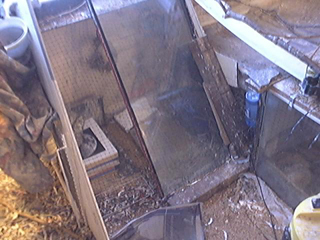
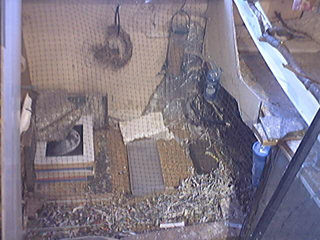
The twig and plastic slat provide access to the water tray on the window cill for the quails and flightless birds. Sedimentary rocks provide a supplement to the cuttle fish bone which some birds prefer. Millet stalks can be poked through the netting or placed in the service area. When these are not available the hen will use the pile of old magazines instead. 10mm pond netting behind the double glazed unit and door prevents escape during servicing and also prevents injury to the birds. The white door which is a light plastic panel is normally used for servicing as it is easier to open. INTERIOR OF THE PEN
A small section of the right hand side adjoins the feeding compartment of the original COMPOUND which provides a certain amount of distraction for the cock during the incubation period. An opened up CD case is fitted to the mesh which is common to both areas to prevent the Love birds pecking the budgies' feet. This eventually got split by the birds and another method is preferred. A single sheet of polycarbonate should be ideal.
INTERSECTION OF THE FEEDING COMPARTMENT
This compartment lies between the Love birds' pen and the HOSPITAL FORECOURT with the SMALL ROOSTER to the left. The pegged hole on the right panel was later added to allow the quails access to the COMPOUND for sleeping or refuge. This was possible because this part of the COMPOUND had become unused for long periods due to more use of the downstairs aviary.
THE LOVE BIRDS' NEST
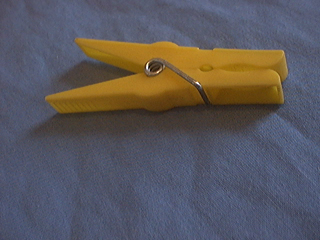
THE STANDARD BLOCKING DEVICE These simple plastic clothes pegs are ideal for blocking entrances to nests and compartments. They are strong and reliable and cannot be pulled off or gnawed away. They are quick to install and allow the birds physical contact - especially important when separating mates. I have used these pegs exclusively for many years without any problems. Types with weak springs or made of wood should be avoided.
|
